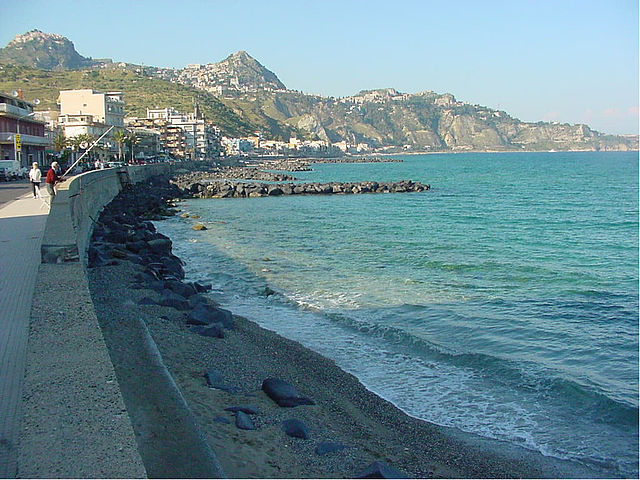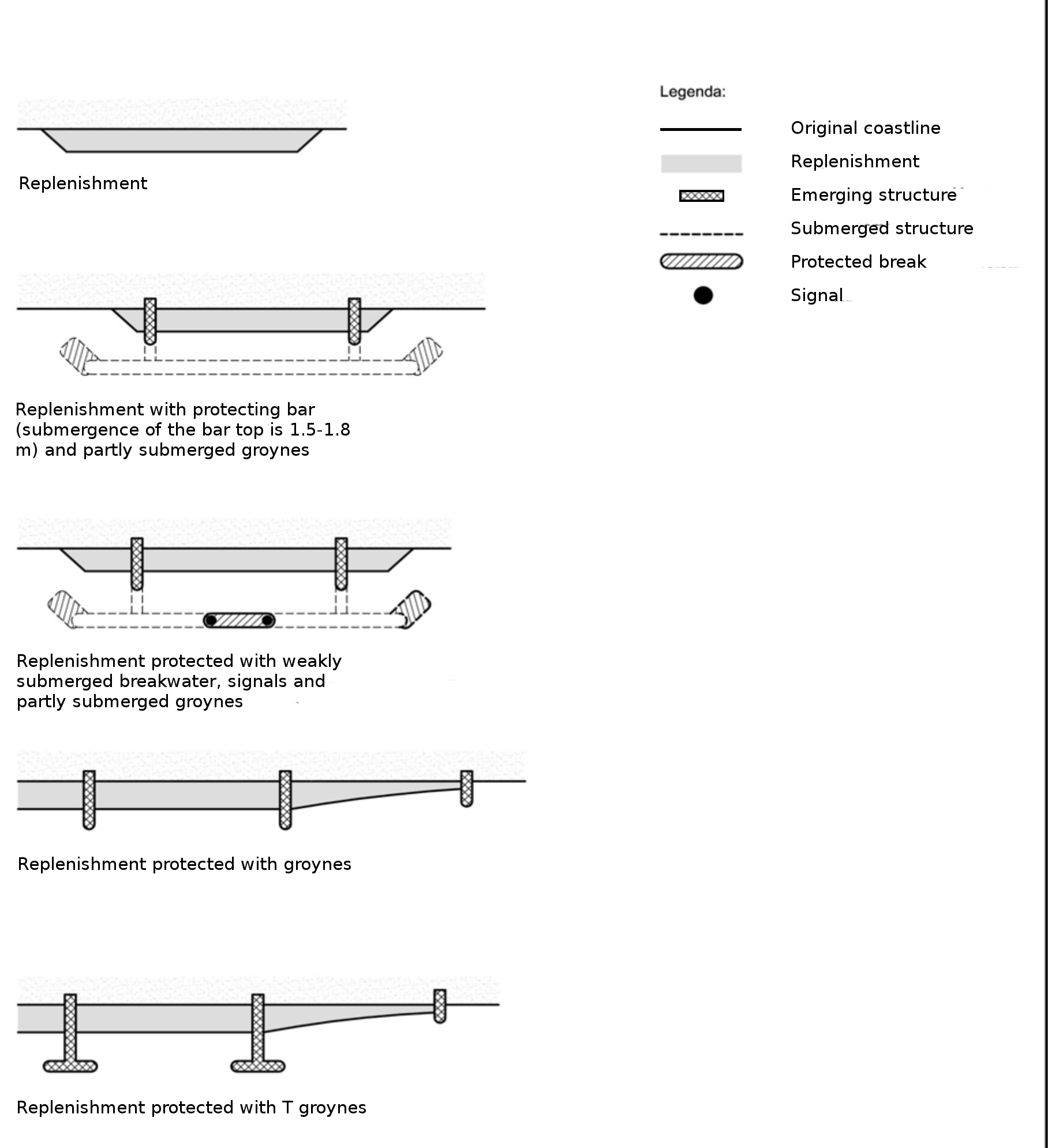Beaches are natural systems that are continuously evolving according to dynamics that are dictated by climate, context and several other forcings including human impact. Their evolution is also characterized by shocks, like for instance extreme meteorological and/or marine events, that may cause sudden changes of the beach's configuration. Beach evolution is studied by beach hydrodynamics and morphodynamics. Beach evolution is sometimes conflicting with the need of maintaining a morphological structure of beaches that ensures the maximum benefit for the ecosystems and the recreational activities that provide fuel to tourism. In order to maintain an optima configuration for beaches, humans have devised protection and recovery strategies.
Interventions for the preservation and maintenance of the morphological behaviors of coasts can be classified into the following main categories:
- Managed retreat. This strategy does not contrast the changes that are occurring in the shoreline, but rather identifies a new line of defence where to construct new protections.
- Interventions to hold the line, such as seawalls.
- Intervention to move the shoreline forward in the seaward direction.
- Indirect measures, like for instance favoring the development of vegetation and complex ecosystems, and policies to control and limit causes that may have a harmful effect on the beach. These measures are also called "green engineering" methods, or "soft engineering methods";
Interventions to hold the line and to move the shoreline forward are also called "direct measures for shore defense". They include infrastructures that are located in the beach area to control its morphological evolution. These are also called "hard engineering methods" and include (1) active measures which modify the local hydrodynamic behaviors in the seashore and therefore sediment transport, and (2) passive measures that protect the coast from erosion without modifying the hydrodynamic circulation of marine water.
Active measures include:
- Breakwaters;
- Groins;
- Beach nourishment (also called beach replenishment);
- Sand by-pass systems.
Passive measures include:
- Seawalls and revetments;
- Berm protections.

Figure 1. Seawall in Sicily. By Oikos-team at English Wikipedia - Transferred from en.wikipedia to Commons., Public Domain, Link
Figure 2 shows a schematic representation of several direct measures for beach protection.

Figure 2. Direct measures for beach protection - Structures. From De Girolamo, P., Le principali tipologie di interventi di difesa costiera, Faculty of Engineering, University of l'Aquila, 2006.

Figure 3. Direct measures for beach protection - Nourishment and nourishment protected with structures. From De Girolamo, P., Le principali tipologie di interventi di difesa costiera, Faculty of Engineering, University of l'Aquila, 2006.
The interventions with infrastructures have been widely used since a long time ago, while methods based on beach nourishment are relatively recent. The reason why infrastructures have been preferred is related to their longer durability, ease of design and constructions, and very often reduced costs. Beach nourishments need to be repeated periodically and do not lend themselves to local interventions. However, experience suggests that hard infrastructures have often induced unexpected drawbacks, like extended impacts along the shoreline and the need for frequent maintenance. Indeed, their impact is often not negligible and structures are a perturbation of the natural context. On the other hand, beach nourishments turned out to be successful, in the long term, in recovering the natural behaviors of beaches, with considerable benefit in term of appeal for tourists. For this reason, after the advent of the green politics there has been an increased consensus towards the use of beach nourishments and indirect methods like recovery of vegetation.
However, one should not underestimate the impact of beach nourishment. First of all, a relevant question is the selection of the sand grain size. Some authors suggest to use larges size sediments, in order to limit the subsequent erosion that would be favored by the increased availability of material. This strategy, however, may impact the touristic appeal of the beach that would look different from its original configuration. Therefore, other authors suggest to use sand of the same original grain size. Furthermore, one should consider that the volume of sand one needs to allocate is higher than expected, especially if increased particle size of the new sand is used, which may induce "overfilling".
Sand by-passing is the process where the longshore sand transport (littoral drift) along the shoreline travels across inlets in the direction of the net sediment transport. A bar may therefore form across the inlet to transport sand to the other side. Training walls may be erected along the cross-shore direction to avoid the formation of the bar to aid navigation. As a result, the training walls trap the littoral drift such that the updrift beach accumulates against the training wall, whilst the downdrift beach erodes due to a lack of sand supply. To avoid the erosion of the downdrift beach a sand by-pass system may be adopted to transport sand in the eroded location. Different strategies may be adopted to transport sand. An interesting example of sand by-pass system is the Tweed Sand Bypassing Project in Australia.
Groins and breakwaters are hard interventions that may impact the natural environment of beaches. With respect to breakwaters, groins present the advantage of preventing longshore transport and keeping the seaward visual open, as in natural pocket beaches. Moreover, groines have a reduced impact on water circulation. On the other hand, breakwaters may be more effective in the presence of significant orthogonal currents. They also do not induce rip currents and may provide more safe conditions for bather and swimmers.
The avoid the disadvantages provided by each solution, the idea is to integrate their advantages by combining breakwaters and groins (see Figure 2 and 3).

Figure 4. Groin at Raversijde (Belgium) - By GdML (Own work) [CC BY-SA 4.0 (http://creativecommons.org/licenses/by-sa/4.0)], via Wikimedia Commons.
In order to ensure durability, beach nourishment may be coupled with structural interventions. For instance, the nourishment may be coupled with a protective bar (see Figure 3) that is placed at the foot of the nourishment, whose top is submerged by 1.5-1.8 meters with respect to the average sea level. The bar is formed by material with larger particle size with respect to the nourishment. A submerged breakwater formed by large boulders could also be adopted. The bar has the purpose of limiting the amplitude of the wave that may erode the nourishment. Such solutions are widely adopted to protect perched beaches that are developed through nourishment along rocky coasts to increase the touristic appeal. The bar should not be used in the presence of a relevant longitudinal currents and associated sediment transport capacity, as in such conditions the effectiveness of this solution would be limited. Particular care should be taken to protect the ends of the bar.
In the presence of even limited longitudinal transport the bar should be associated to groins, submerged or not, to create a series of rectangular cells (see Figure 3). The limited exchange of material between neighboring cells increases the durability of the solution. These structures may be created with boulders, sand bags, or geotextiles filled with sand. These interventions have been frequently adopted in Italy in the past decades and the results turned out to be not always good.
Nourishments may also be protected with groins only. The most effective solution seems to be the use of long groins placed at large longitudinal distance, therefore creating "pocket beaches". Particular care should be taken in checking the possible presence of rip currents, namely, orthogonal seaward currents which may move the nourishment away, may undermine the stability of the groins and may be dangerous for swimmers. T groins are a possible solution to avoid rip currents. They are more expensive as the extremity of the groins is directly exposed, along the longitudinal direction, to sea waves. Therefore, the T groins need robust foundations.
Seawalls are the most frequently passive protection of beaches, which has been used since ancient times. They are typically used to protect areas of human habitation, conservation and leisure activities. Usually they do not protect beaches but rather hard structures like sidewalks, roads and other civil structures and infrastructures. The seawall presents the disadvantage of creating a barrier between the protected area and the sea. Moreover, it often has a relevant impact on the landscape and therefore it should not be used in protected environments. although it may be constructed by using natural materials like boulders or geotextils. The main advantage of seawalls is given by their effectiveness and durability. The disadvantages are the high economic cost, the lack of protection for the beach underneath, the reflection of wave energy leading to scour at their base, the potential disruption of the natural shoreline and destroy of shoreline habitats such as wetlands and intertidal beaches, the alteration of sediment transport processes.
A less impacting protection measure is berm protection with hard structures. The berm is the nearly sub-horizontal portion of beach that stays dry except during extremely high tides and storms. If the berm is protected with a hard revetment then a barrier against erosion is created therefore preserving the berm itself. This measure does not protect the beach face and the swash zone. Moreover, berm protection may have a relevant impact on the landscape and therefore it may be not useful for preserving the touristic appeal.
Indirect measures that are gaining more and more popularity in recent times are attempts to reconstruct the natural environment of the beach that has been eroded. These measures may be advisable to recover the cases where erosion has been triggered by an extreme event that destroyed the natural structure and vegetation of the beach. The measures may include beach nourishment to reconstruct the form of the beach, including berm and foredune, berm protection with boulder and/or cobbles, and reconstruction of the native vegetation of the dune.
Last updated: March 21, 2017
- 170 views
